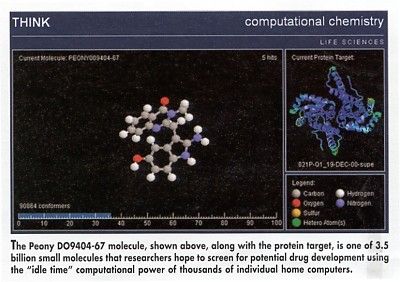‘Virtual Supercomputer’ Program for Cancer Drug Discovery
SANTA CLARA, Calif-Intel Corporation has announced an innovative medical research program that enlists the help of millions of personal computer users to speed up the drug discovery process. The program harnesses the "idle time" computational power of individual home computers to create a "virtual supercomputer."
SANTA CLARA, CalifIntel Corporation has announced an innovative medical research program that enlists the help of millions of personal computer users to speed up the drug discovery process. The program harnesses the "idle time" computational power of individual home computers to create a "virtual supercomputer."
This virtual computerexpected to be 10 times more powerful than any existing supercomputeris already at work screening millions of molecules for their ability to bind with proteins associated with cancer development (see Figure).

The Intel Philanthropic Peer-to-Peer Program allows individuals to donate their unused computing capability to solving medical problems, all at no cost to the individual computer user. Cancer drug research is the first beneficiary of the new program, but other medical applications are expected to follow, such as those aimed at Parkinson’s disease, and diabetes.
"If we have millions of personal computers attached to the Internet, we can partition the solution of a problem, download bits and pieces of the problem to those individual computers, let them solve their bit of the problem in the background, and then upload that solution and repeat the cycle," Craig Barrett, president and CEO of Intel, said at a press conference. "On that basis, we effectively get the computational capability of perhaps millions of computers all working in parallel to solve the problem."
The program brings something to the research community "that hasn’t been available ever beforeunlimited computer power at almost no cost," Mr. Barrett continued. "And that will allow us to ask, and hopefully answer, questions that people have never considered attacking before because the computer requirements were outside the realm of possibility."
The leukemia drug-optimization program is supported by the National Foundation for Cancer Research (NFCR), the University of Oxford, and software developer United Devices, Inc, and is endorsed by the American Cancer Society.
Researchers involved in the program believe it has the potential to shave at least 3 years off the time normally required to design a new cancer drug.
According to Graham Richards, DPhil, DSc, chairman of chemistry at Oxford, the vast computational power afforded by the donated computer time will enable researchers to analyze, in a relatively short time, hundreds of millions of small molecules for their ability to bind with a target protein.
The NFCR Center for Computational Drug Discovery at Oxford currently has a database of 3.5 billion small molecules ready to be tested for potential drug development. NFCR scientists estimate that the evaluations will require a minimum of 3 billion hours of computation time-an unimaginable task with conventional approaches.
Dr. Richards explained the process: Researchers will examine the binding sites of target proteins to find points in the binding sites that could attract and bind small molecules. Then, they will add binding points onto each of the 3.5 billion small molecules currently in the Oxford center’s database. "We let the molecule change shape, and then in a quick and crude way, taking less than 1 minute per molecule, the software calculates how well it binds to the target," he said.
The researchers then score the "binding energies" of the small molecules to determine which ones might be worth pursuing as a potential new drug.
The first protein target is superoxide dismutase (SOD), an enzyme overexpressed in leukemia cells. Programs for other targetsincluding ras proteins, vascular endothelial growth factor, and tyrosine kinaseare ready to go immediately, Dr. Richards said. In test runs for the SOD program, many thousands of small molecules were analyzed and some appear to be hits. "Interestingly, these hits are different from the standard molecules that are currently being researched," Dr. Richards said. "So this is, in my quite long scientific lifetime, far and away the most exciting thing I’ve ever been involved in."
Sujuan Ba, PhD, science director of the NFCR, calls the new program the dawning of a new era in cancer research. "The program will identify at least 100,000 new drug candidate molecules for further biological testing," Dr. Ba said. "We are very hopeful that one or, if we are lucky, several breakthroughs will be identified, and maybe one or several revolutionary new drugs will be developed to cure leukemia and other cancers."
Getting Involved
To participate in the volunteer program, computer users download a small program from www.intel.com/cure. The user runs the file and follows the installation instructions. Once installed, the program immediately begins to perform its data analysis whenever computation resources are available.
When the analysis is complete, typically a day later, the results are automatically sent to the data center at United Devices the next time the user connects to the Internet. At the same time, the program requests a new packet of molecular data to analyze, and the process begins again.
The program is similar to a screen-saver, which operates without prompting during regular computer use. Because the research program runs in the background and backs down whenever a regular application requires computing power, users should not notice that the research program is running.
The goal is to have 6 million computers participating this year, out of a staggering 500 million computers connected to the Internet. The project is an unprecedented opportunity for cancer patients, their family and friends, and anyone else interested in fighting this disease to actually participate in the search for better treatments and even cures.